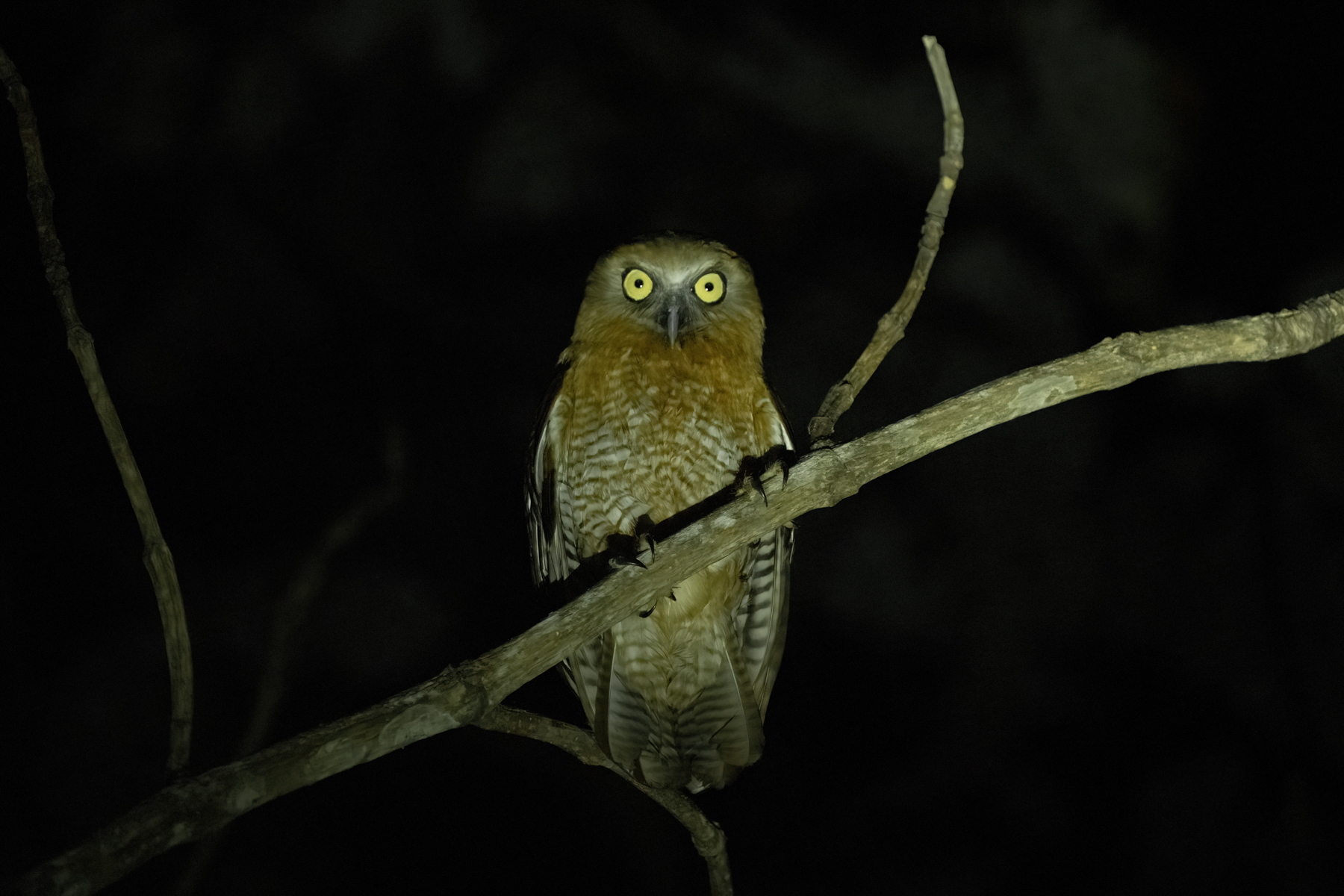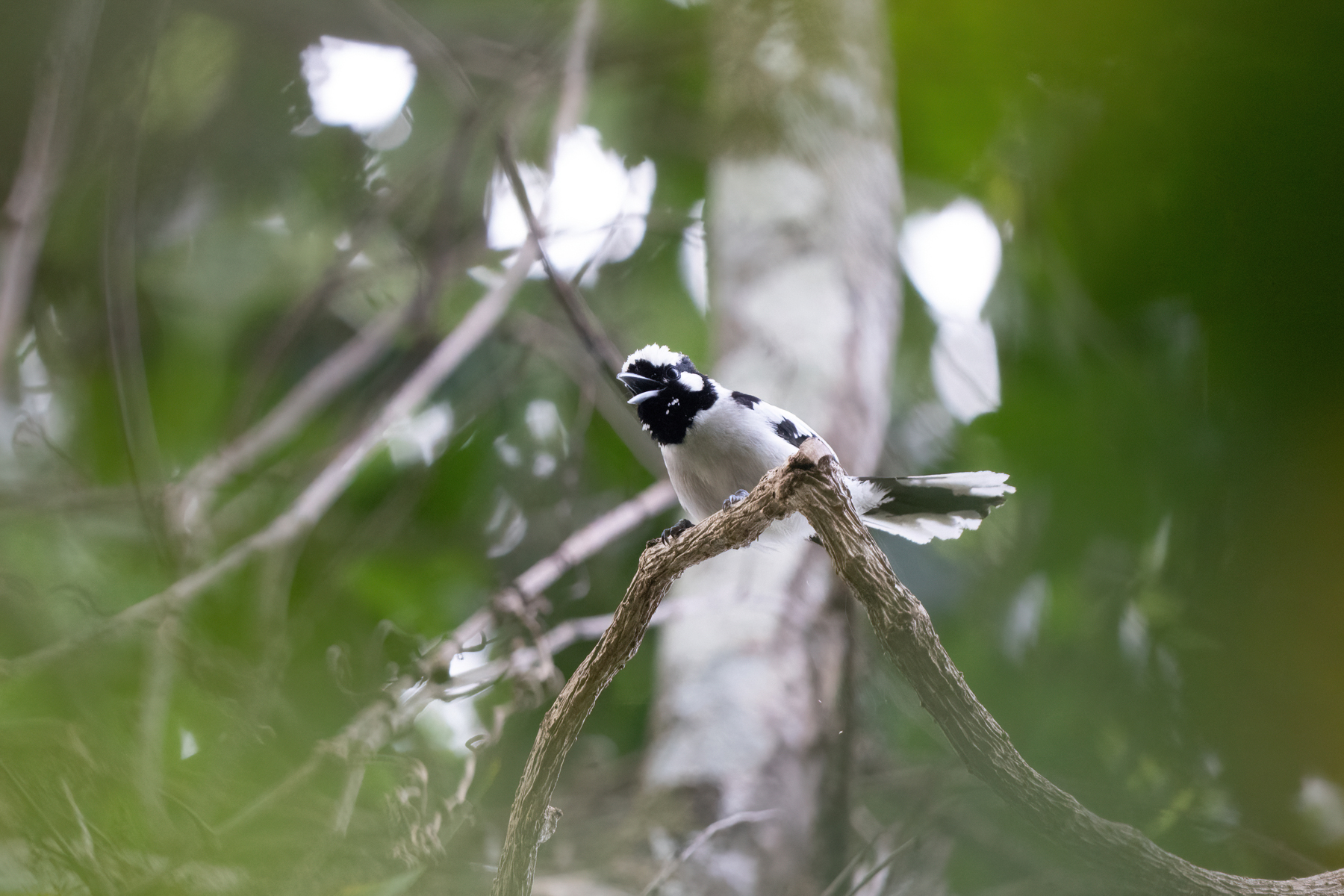REMOTE ISLANDS OF THE BANDA SEA, INDONESIA BIRDING TOUR: DETAILED ITINERARY
Banda Sea, Indonesia: Day 1 Our Banda Sea birding tour begins in the morning at Labuan Bajo (Komodo) on the island of Flores.
[You can fly into Labuan Bajo (Komodo) from either Jakarta or Denpasar (Bali). If you need flights and/or hotel bookings, we can assist.]
Here we will board our comfortable schooner, our home for the next 13 nights, and set sail northwards towards the remote island of Tanahjampea, our first destination.
Numbers of seabirds should entertain us during the daylight crossings between the islands. The most likely seabird species during our voyage are likely to include Brown and Red-footed Boobies (both numerous at times), Great and Lesser Frigatebirds, Wilson’s Storm Petrel, Bulwer’s Petrel, Streaked Shearwater, Pomarine, Parasitic (or Arctic) and Long-tailed Jaegers, Brown Noddy and Sooty, Bridled, Black-naped, Common and Greater Crested Terns. In addition, Red-necked Phalaropes migrate to the Banda Sea to overwinter. Scarce species include White-tailed and Red-tailed Tropicbirds, Heinroth’s and Wedge-tailed Shearwaters and Little Tern. Heinroth’s Shearwater is poorly known and could even breed in the region.
During this cruise the potential of finding something unexpected is high. In recent times, a series of rarities have been sighted in the Banda Sea, including Red-billed Tropicbird, Swinhoe’s and Matsudaira’s Storm Petrels, Tahiti Petrel, Tropical Shearwater, Christmas (Island) Frigatebird, Aleutian and Spectacled (or Grey-backed) Terns and even Abbott’s Booby, so we will be keeping a careful eye out for whatever turns up.
During the inter-island crossings, we will also encounter a number of cetaceans. The most regular are Indo-Pacific Bottle-nosed and Spinner Dolphins. The huge Blue Whale and Great Sperm Whale are quite regularly recorded and less frequent sightings include Pantropical Spotted, Risso’s and Rough-toothed Dolphins, Short-finned Pilot Whale, Bryde’s, Fin, Sei and Melon-headed Whales and False and Pygmy Killer Whales. A remarkable diversity of species!
Banda Sea, Indonesia: Days 2-13 Exploring the islands of the Banda Sea.
TANAHJAMPEA
The island of Tanahjampea is around 25 kilometres (27 miles) long and is situated between the huge islands of Sulawesi and Flores. Its remoteness means that only very few birders have ever visited the island, despite its specialities.
On Tanahjampea we will mainly be looking for three seldom-recorded species; Tanahjampea Blue Flycatcher (or Tanahjampea Jungle Flycatcher), Tanahjampea (or White-tipped) Monarch and Flores Sea Cuckoo-Dove.
The endangered Tanahjampea Monarch is endemic to the island. Tanahjampea Blue Flycatcher is also endemic to Tanahjampea (unless the Cyornis blue flycatcher form kalaoensis on nearby Kalao is lumped with it rather than lumped with Mangrove Blue Flycatcher as at present by the IOC or treated as a distinct species). Flores Sea Cuckoo-Dove is endemic to several small islands in the region.
Other likely species include Orange-footed Scrubfowl, Asian Emerald Dove, Elegant (or Yellow-eyed), Pink-headed and Pied Imperial Pigeons, Great-billed Heron, Pacific Reef Egret, Javan Pond Heron, White-bellied Sea Eagle, Collared Kingfisher, Elegant Pitta (of the form virginalis), Sulawesi Myzomela, Black-naped Oriole, White-breasted Woodswallow, Arafura (or Supertramp) Fantail, Lemon-bellied White-eye, Blue-cheeked (or Red-chested) Flowerpecker and Olive-backed Sunbird of the form teysmanni (known as ‘Flores Sea Sunbird’). There are also chances for Sunda Teal, Pink-necked and Grey-cheeked Green Pigeons, Glossy Swiftlet and Malaysian Plover.
At this season we can expect to encounter a good selection of Palearctic landbird and coastal wetland migrants from northern Eurasia during our Banda Sea voyage, although which islands we see individual species on will vary widely from trip to trip. Many of these migrants are shorebirds, but there are also passerines and others. Among the most likely species are Oriental Cuckoo, Pacific Swift, Pacific Golden Plover, the sought-after Oriental Plover and Little Curlew (surprisingly regular in the Banda Sea area in late September and October), Grey-tailed Tattler, Terek, Common and Marsh Sandpipers, Common Greenshank, White-winged and Whiskered Terns, Eastern Osprey, Crested (or Oriental) Honey Buzzard, Barn Swallow and Grey Wagtail.
More uncommon migrant possibilities during our expedition include White-throated Needletail, Grey (or Black-bellied) and Greater Sand Plovers, Wood Sandpiper, Common Redshank, Ruddy Turnstone, Sanderling, Red-necked Stint, Far Eastern (or Eastern) and Eurasian Curlews, Chinese Goshawk, Japanese Sparrowhawk, Grey-streaked Flycatcher and Eastern Yellow Wagtail.
KALAO
The nearby island of Kalao hosts another endemic form, ‘Kalao Blue Flycatcher’, currently subsumed in either Tanahjampea Blue Flycatcher or Mangrove Blue Flycatcher. However, the subspecies kalaoensis has recently been proposed as a distinct species, based on differences in morphology and vocalisations.
After our visit to Kalao, we will set sail eastwards towards the island of Kalaotoa.
KALAOTOA
A visit to the small island of Kalaotoa will give us an opportunity to find two distinctive endemic subspecies of Arafura (or Supertramp) Fantail and Rufous-sided (or Banda Sea) Gerygone, both shared with the neighbouring island of Madu, which we don’t want to miss in case they get split in the future.
We will then sail southeastwards across the Banda Sea towards the islands of Pantar and Alor in the Lesser Sundas.
We will have a good opportunity to see both seabirds and cetaceans on this leg of the journey. In particular, this is the best area for the uncommon Heinroth’s Shearwater.
ALOR (& PANTAR)
We will spend plenty of time on the island of Alor, where the recently described Alor Myzomela and also ‘Alor Cuckooshrike’ (the alfrediana taxon is currently grouped under Wallacean Cuckooshrike but lacks sexual dimorphism) will be two of our main endemic targets. Pristine eucalyptus forest patches still remain near the highest point of the island and are prime habitat for these species. Another important target, but not an easy one by any means, is ‘Eucalypt Cuckoo-Dove’ (an undescribed form that is vocally distinct from Little Cuckoo-Dove).
Other likely birds in this habitat include the smart Banded (or Black-backed) Fruit Dove, Bonelli’s Eagle of the isolated subspecies renschi, the sylvestris form of the Variable Goshawk (split by Birdlife International as Lesser Sundas Goshawk), Olive-headed Lorikeet and Sunda Bush Warbler (the forms kolichisi on Alor and everetti on Timor and Wetar may well represent different species).
Another target is ‘Timor Bush Warbler’. The form timorensis is currently lumped in Javan Bush Warbler (which is also known as Sunda Grasshopper Warbler) but is nowadays not recorded on tours visiting West Timor. Flores Green Pigeon is also quite possible but is not an easy bird on either Flores or Alor.
We will also have opportunities to observe two critically endangered species, Flores Hawk-Eagle and Yellow-crested Cockatoo. Now that Komodo has been rendered very difficult of access by the Indonesian government, Alor is probably the best remaining site for this rapidly declining cockatoo. While the cockatoo is fairly straightforward to find the hawk-eagle is decidedly uncommon.
At lower altitudes, dry forest is inhabited by typical Lesser Sundas specialities like Ornate Pitta, Barred Dove, Black-fronted Flowerpecker and Flame-breasted Sunbird, as well as Broad-billed Flycatcher (or Broad-billed Monarch).
As dusk falls we will be looking for the recently elevated, near-endemic Alor Boobook, which was formerly considered a subspecies of Australian (or Southern) Boobook. Alternatively, we may decide to look for Alor Boobook on the adjacent island of Pantar, the only other island on which it occurs.
Other species likely on Alor include Spotted Dove, Pacific Emerald Dove, Black-naped Fruit Dove, Edible-nest Swiftlet, Pacific Koel, Lesser Coucal, White-breasted Waterhen, Spotted (or Indonesian) Kestrel, Peregrine Falcon, Rainbow Bee-eater, Sunda Pygmy Woodpecker, Helmeted Friarbird, the limbata form of the Brown Honeyeater (sometimes split as Indonesian Honeyeatear), White-shouldered (or Leseur’s) Triller, Long-tailed Shrike, Large-billed Crow, Cinereous Tit, Pacific, Striated and Tree Swallows, Zitting Cisticola, Lesser Pied Flycatcher, Pied Bush Chat, Olive-backed Sunbird (here of the form ornatus, known as ‘Ornate Sunbird’), Zebra Finch and Scaly-breasted and Black-faced Munias. In addition, Black-winged Kite, Short-toed Snake Eagle, Barred Buttonquail, Oriental Dwarf Kingfisher, Black-naped Monarch, Warbling White-eye, Lesser Shortwing and Pale-headed Munia are also possible.
From Alor, we will travel eastwards to the island of Wetar.
WETAR
Wetar, while politically part of the Maluku (or Moluccas) islands, is geographically part of the Lesser Sundas and shares most of its avifauna with the nearby island of Timor. However, a number of species are either endemic to Wetar or easier to see on Wetar. These will be our main targets during our visit.
Without a doubt, our number one target will be Wetar Ground Dove, an endangered species which was not recorded for over 100 years, before being rediscovered on Wetar by the Columbidae Conservation charity and found to be locally abundant. We will be walking in a deep, pristine wooded gorge in search of this very special bird which otherwise only still occurs in East Timor (Timor Leste) where it is apparently extremely rare.
Those having already travelled elsewhere in the Lesser Sundas will be stunned by the abundance of pigeons and doves, thanks to the absence of widespread hunting and trapping on Wetar. This will be obvious during the course of the day, as Timor and Black Cuckoo-Doves, Timor Imperial Pigeon (which is nowadays very difficult at accessible sites in West Timor), Pink-headed Imperial Pigeon and Banded (or Black-backed) Fruit Dove thrive on this island, giving the best possible observation opportunities.
We will keep our eyes peeled for other Wetar endemics including Black-necklaced Honeyeater, Wetar (or Crimson-hooded) Myzomela, Wetar Oriole and Wetar Figbird. At night, we will be looking for the endemic Wetar Scops Owl.
We will also look for several species shared only with the nearby island of Timor (and sometimes Rote) including the uncommon Iris Lorikeet, Jonquil (or Olive-shouldered) Parrot, the so far undescribed ‘Timor Nightjar’, ‘Timor Cuckooshrike’ (a potential split from Wallacean), ‘Timor Fantail’ (a proposed split from Northern), Timor Stubtail, Timor Leaf Warbler (the form on Wetar probably represents a distinct species) and Timor Blue (or Timor Warbling) Flycatcher.
We will also be seeing our first Scaly-breasted (or Banda or White-tufted) Honeyeaters, endemic to the islands of the eastern part of the Banda Sea.
Species of a somewhat wider distribution include Cinnamon-banded Kingfisher, Marigold Lorikeet, Red-cheeked Parrot, Plain (or Timor) Gerygone, Rusty-breasted Whistler, Arafura (or Supertramp) Fantail, Orange-sided (or Orange-banded Thrush), Ashy-bellied White-eye, Tawny Grassbird and Blue-cheeked (or Red-chested) Flowerpecker. Common Kingfisher is also likely.
From Wetar, we will sail eastwards towards Leti.
LETI
This remote, arid island (one of the driest in Indonesia) holds Grey (or Kisar) Friarbird, which is endemic to the three small islands of Kisar, Leti and Moa, making it one of Indonesia’s most range-restricted and inaccessible species.
Other potential new birds include Brown Goshawk, Brown Quail (uncommon), Metallic Pigeon, Rose-crowned Fruit Dove, the rufomenus subspecies of the Little Bronze Cuckoo (initially described as a distinct species and known as ‘Banda Bronze Cuckoo’), the restricted-range Drab Swiftlet, Scaly-breasted (or Banda or White-tufted) Honeyeater, the restricted-range Fawn-breasted Whistler and ‘Banda Sea Fantail’ (a proposed split from Northern).
As dusk falls we will be looking for the near-endemic moae subspecies of the Australian (or Southern) Boobook before boarding our boat again and heading north-eastwards towards our next destination, the island of Damar. We may also come across Savanna Nightjar.
DAMAR
Damar is a small island of roughly 20 kilometres (12 miles) diameter and hosts one of the most exciting endemics of the whole cruise, Damar Flycatcher, whose range is entirely restricted to this tiny island. It was discovered in 1898 by a German collector and remained unseen for 103 years, before being rediscovered in 2001 by a Birdlife International expedition led by Colin Trainor. Since then, only a small number of birders have reached the island to see this species, considered one of the most inaccessible on Earth. We will be walking uphill in moist tropical forest in search of this distinctive endemic, which happily is fairly common.
Other species on Damar include Rose-crowned and Banded (or Black-backed) Fruit Doves, Elegant (or Yellow-eyed) and Pink-headed Imperial Pigeons, Little Bronze Cuckoo, Variable Goshawk, Cinnamon-banded Kingfisher, Scaly-breasted (or Banda or White-tufted) Honeyeater, ‘Damar Whistler’ (currently often treated as a subspecies of the Yellow-throated Whistler), the restricted-range Wallacean Whistler, ‘Banda Sea Fantail’, Spectacled Monarch, Black-bibbed Monarch (found only on Damar, Babar and Tanimbar), Orange-sided Thrush and Blue-cheeked (or Red-chested) Flowerpecker.
From Damar, we will cruise southeastwards towards our next destination, the island of Babar.
BABAR
Babar island is roughly 30 kilometres (18 miles) across and shares most of its avifauna with the much larger island of Timor and the Tanimbar archipelago. During our visit we will be birding through a variety of woodlands, searching in particular for ‘Babar Whistler’, a distinctive form likely to be split from Yellow-throated Whistler.
The supporting cast may include Banded (or Black-backed), Wallace’s and Rose-crowned Fruit Doves, Cinnamon-banded Kingfisher, Scaly-breasted (or Banda or White-tufted) Honeyeater, Banda Myzomela, Rufous-sided (or Banda Sea) Gerygone, Wallacean Whistler, Arafura (or Supertramp) Fantail, Cinnamon-tailed Fantail (the form occurring on Babar has a distinctive song and could represent a different species from the Tanimbar population), Island and Black-bibbed Monarchs, Orange-sided Thrush and Tricoloured Parrotfinch.
At dusk, we will look in particular for the endemic subspecies of the Australian Boobook, known as ‘Babar Boobook’, which is morphologically strikingly different from its southern counterpart (which its rich cinnamon body and grey face) and may represent a different species (despite its similar vocalisations). Large-tailed Nightjar and Eastern Barn Owl are also possible.
Banda Sea, Indonesia: Day 14 While sailing from Babar to Yamdena island in the Tanimbar archipelago, we will stop at a small islet to look for Tanimbar’s most tricky endemic, the Tanimbar Megapode (or Tanimbar Scrubfowl). This is a hard bird to see on Yamdena, the main island of the Tanimbars, but easier on the small islands with reduced hunting pressure. Other new birds may include Beach Stone-curlew (or Beach Thicknee) and Pied Oystercatcher.
The seaborne section of our Banda Sea birding expedition ends today at Saumlaki, on the island of Yamdena in the Tanimbar archipelago, where we will spend the next three nights ashore at a hotel. This afternoon we will commence our exploration of Yamdena.
Banda Sea, Indonesia: Days 15-16 The Tanimbar Islands form the easternmost group of the Lesser Sundas (Nusa Tenggara) and, from a zoogeographical standpoint, are not part of the Moluccas, although politically they are considered part of Maluku. Currently, 15 species of birds are strictly endemic to the archipelago, and there are a number of near-endemics shared with the Kai Islands or with Babar and/or Damar.
In the past, there were some violent clashes between logging companies and local villagers over the irresponsible destruction (i.e. absolute clearing) of the forests on Yamdena, but luckily the situation has long since calmed down, and the locals concentrate once again on farming, fishing, ikat weaving and the carving of ‘patongs’ or wooden figures.
We will explore patches of forest along the main road that runs along the east coast of the island. Logging trails provide access to some good stands of forest and the mosaic of scrub, grassland and secondary growth will also provide us with some exciting birding.
Tanimbar Corella (or Tanimbar Cockatoo) is one of the most wanted endemics in this part of Indonesia, and can still be found easily, although the two endemic thrushes are much more dramatic in appearance. Diligent searching of the tracks and watercourses should reveal the presence of the Fawn-breasted Thrush, whilst the strikingly-patterned and more obvious Slaty-backed Thrush prefers the subcanopy.
The endemic Tanimbar Stubtail (or Tanimbar Bush Warbler) is a skulker that will need the right amount of careful coaxing before good views will be obtained. This species was only described as recently as 1987.
Bird flocks often hold the endemic Cinnamon-tailed and Long-tailed (or Charming) Fantails, together with the endemic fulviventris form of the Broad-billed Flycatcher (or Broad-billed Monarch) and the endemic Tanimbar (or Loetoe) Monarch. In the understorey, we will encounter the endemic Tanimbar Flycatcher, while the brightly-coloured endemic Golden-bellied Flyrobin tends to sit in the open. Flowering trees often attract flocks of unobtrusive endemic Tanimbar Starlings and gaudy endemic Blue-streaked Lories. Elegant (or Yellow-eyed) and Pink-headed Imperial Pigeons, Rose-crowned Fruit Doves (of the modestly-hued xanthogaster race), magnificent Wallace’s Fruit-Doves and endemic Tanimbar Cuckoo-Doves gather in fruiting trees, while the splendid Pied Bronze Cuckoo leads a quiet life hiding in the canopy. The endemic White-browed (or Tanimbar) Triller often poses in the treetops and the dainty, regionally endemic Rufous-sided (or Banda Sea) Gerygone flits about in the mid-storey.
We will go out at night, armed with a spotlight to try for the more straightforward endemic Tanimbar Boobook and, with persistence and a bit of luck, we will also encounter the endemic nominate form of the Moluccan Masked Owl.
Other special birds we can expect to encounter on Yamdena include the endemic Tanimbar Oriole, the near-endemic Tanimbar Friarbird (shared with Kai), the near-endemic Banda (or Black-breasted) Myzomela (shared with Babar) and the near-endemic Violet-hooded Starling (shared with Damar). Additional specialities include Mistletoebird of the distinctive race fulgidum that is sometimes split as Salvadori’s Flowerpecker.
The shy endemic Tanimbar Megapode (or Tanimbar Scrubfowl) inhabits the dark forest interior and can be heard duetting in the vicinity of its huge nest mounds, although it takes persistence and a bit of luck to set eyes on one owing to hunting pressure. It is definitely the hardest Tanimbar endemic to see on Yamdena and is easier on the offshore islets where hunting is absent or reduced.
More widespread species include Uniform Swiftlet, Australian Pratincole, Eastern Cattle Egret, Brahminy Kite, Pacific Baza, Bonelli’s Eagle (of the form renschi, known as Rensch’s Eagle), the eye-catching Cinnamon-banded Kingfisher, Sacred Kingfisher, Oriental Dollarbird, Australian Hobby, Eclectus and Great-billed Parrots, the restricted-range Wallacean Whistler, Wallacean Cuckooshrike, Arafura (or Supertramp) Fantail, Shining Flycatcher (or Shining Monarch), Ashy-bellied White-eye, Golden-headed Cisticola, Metallic Starling, Scaly-breasted (or Banda) Honeyeater, Five-coloured Munia and the gorgeous Tricoloured Parrotfinch. Uncommon possibilities include the attractive Azure Kingfisher and the surprisingly scarce Torresian Crow.
Along the coast, we should find Great and Lesser Frigatebirds, Little Black and Little Pied Cormorants, Great and Little Egrets, Striated Heron, Nankeen (or Rufous) Night Heron, Australian Pelican, White-bellied Sea Eagle and Pacific Swallow.
Banda Sea, Indonesia: Day 17 Our Banda Sea birding tour ends this morning at Saumlaki. Depending on flight schedules, we may have time for some final birding.
(Flights out of Saumlaki mainly go to the island of Ambon, a major hub from where there are flights to Jakarta, Makassar, Denpasar and other cities.)








































































































